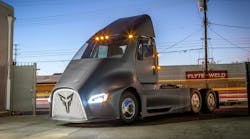There has been so much coverage and hype about electric vehicles that it can be hard to separate fact from fiction. Speaking at a recent NationaLease meeting Giordano Sordoni, co-founder and COO of Thor Trucks, said there are certain applications where battery electric vehicles should do well. Those include:
- Short and medium ranges
- Lots of starts and stops
- Noise sensitivity
- Lots of idling
Sordoni told the audience that one of the reasons electric vehicles make sense now is that battery technology has improved. In addition, many countries have announced partial or complete bans on combustion-engine vehicle sales by 2025 or in some cases sooner. The growth of e-commerce and the desire for next-day or even same-day delivery is another factor that plays into the growth of electric vehicles as more package delivery will be shifted to consumers’ homes.
Citing data from McKinsey & Co., and the Department of Transportation, Sordoni said the forecast is for commercial electric vehicles to grow to 100,000 by 2022, 500,000 by 2026 and one million by 2030. Predictions are that between 250,000 and 300,000 new commercial electric vehicles will be sold in the U.S. by 2030.
There are, however, some stumbling blocks that electric vehicles will have to overcome if they are to gain general, widespread acceptance including the need for the simultaneous charging of multiple vehicles. Today there is a limited amount of power on-site at fleet yards, so fleets may not be able to handle charging needs. In fact, he said that approximately 90% of commercial and industrial buildings in the U.S. do not have enough power to charge even five electric trucks. In addition, upgrading infrastructure to accommodate electric vehicles takes time — three to seven years.
While these challenges exist, there is also an increased interest in infrastructure improvement and commercial and industrial customers are looking at local electricity storage and generation.
It’s unlikely that electric vehicles will replace all the trucks on the road in the short term. However, the reality is that electric vehicles are progressing to a point where they will make an inroad into the market in a relatively short period of time. Now is the time to begin familiarizing yourself with the pluses and minuses of electric vehicles so you can make the right decision when it comes to adding them to your fleet.



